tow TOYOTA YARIS 2022 Owners Manual
[x] Cancel search | Manufacturer: TOYOTA, Model Year: 2022, Model line: YARIS, Model: TOYOTA YARIS 2022Pages: 590, PDF Size: 128.6 MB
Page 5 of 590
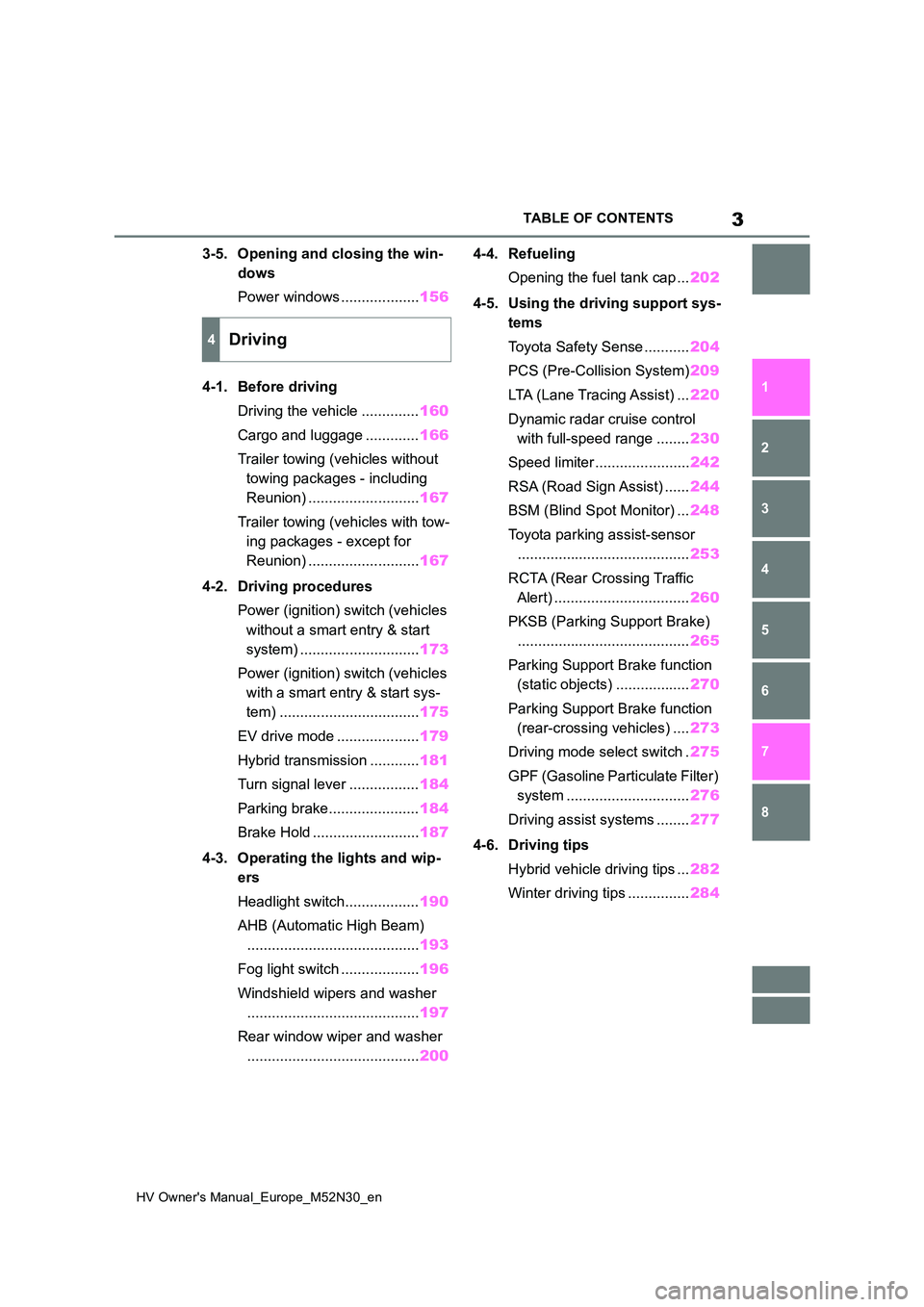
3
HV Owner's Manual_Europe_M52N30_en
TABLE OF CONTENTS
1
6
5
4
3
2
8
7
3-5. Opening and closing the win-
dows
Power windows ................... 156
4-1. Before driving
Driving the vehicle .............. 160
Cargo and luggage ............. 166
Trailer towing (vehicles without
towing packages - including
Reunion) ........................... 167
Trailer towing (vehicles with tow-
ing packages - except for
Reunion) ........................... 167
4-2. Driving procedures
Power (ignition) s witch (vehicles
without a smart entry & start
system) ............................. 173
Power (ignition) s witch (vehicles
with a smart entry & start sys-
tem) .................................. 175
EV drive mode .................... 179
Hybrid transmission ............ 181
Turn signal lever ................. 184
Parking brake...................... 184
Brake Hold .......................... 187
4-3. Operating the lights and wip-
ers
Headlight switch.................. 190
AHB (Automatic High Beam)
.......................................... 193
Fog light switch ................... 196
Windshield wipers and washer
.......................................... 197
Rear window wiper and washer
.......................................... 200
4-4. Refueling
Opening the fuel tank cap ... 202
4-5. Using the driving support sys-
tems
Toyota Safety Sense ........... 204
PCS (Pre-Collision System) 209
LTA (Lane Tracing Assist) ... 220
Dynamic radar cruise control
with full-speed range ........ 230
Speed limiter ....................... 242
RSA (Road Sign Assist) ...... 244
BSM (Blind Spot Monitor) ... 248
Toyota parking assist-sensor
.......................................... 253
RCTA (Rear Crossing Traffic
Alert) ................................. 260
PKSB (Parking Support Brake)
.......................................... 265
Parking Support Brake function
(static objects) .................. 270
Parking Support Brake function
(rear-crossing vehicles) .... 273
Driving mode select switch . 275
GPF (Gasoline Particulate Filter)
system .............................. 276
Driving assist systems ........ 277
4-6. Driving tips
Hybrid vehicle driving tips ... 282
Winter driving tips ............... 284
4Driving
Page 7 of 590

5
HV Owner's Manual_Europe_M52N30_en
TABLE OF CONTENTS
1
6
5
4
3
2
8
7
7-2. Steps to take in an emergency
If your vehicle needs to be towed
.......................................... 369
If you think something is wrong
.......................................... 372
If a warning light turns on or a
warning buzzer sounds..... 374
If a warning message is dis-
played ............................... 383
If you have a flat tire (vehicles
with an emergency tire punc-
ture repair kit) ................... 386
If you have a flat tire (vehicles
with a spare tire) ............... 397
If the hybrid system will not start
.......................................... 405
If you lose your keys ........... 407
If the electronic key does not
operate properly (vehicles with
a smart entry & start system)
.......................................... 407
If the 12-volt battery is dis-
charged............................. 409
If your vehicle overheats ..... 414
If the vehicle becomes stuck
.......................................... 417
8-1. Specifications
Maintenance data (fuel, oil level,
etc.)................................... 420
Fuel information .................. 430
8-2. Customization
Customizable features ........ 431
8-3. Initialization
Items to initialize ................. 440
8-4. Certifications
Certifications ....................... 441
What to do if... (Troubleshooting)
.......................................... 572
Alphabetical Index .............. 575
8Vehicle specifications
Index
Page 16 of 590

14
HV Owner's Manual_Europe_M52N30_en
Pictorial index
■Instrument panel (left-hand drive vehicles)
Power switch ..........................................................................P.173, 175
Starting the hybrid system/changing the positions*1........................P.173
Starting the hybrid system/changing the modes*2...........................P.175
Emergency stop of the hybrid system ............................ ..................P.366
When the hybrid system will not start .......................... ....................P.405
Warning messages ............................................... ...........................P.383
Shift lever.................................................... ....................................P.181
Changing the shift position.................................... ...........................P.181
Precautions for towing ......................................... ............................P.369
When the shift lever does not move............................. ....................P.182
Meters ......................................................... ................................P.94, 99
Reading the meters/adjusting the instrument panel light ........ .....P.94, 99
Warning lights/indicator lights ................................ ............................P.90
When a warning light turns on .................................. .......................P.374
Page 23 of 590
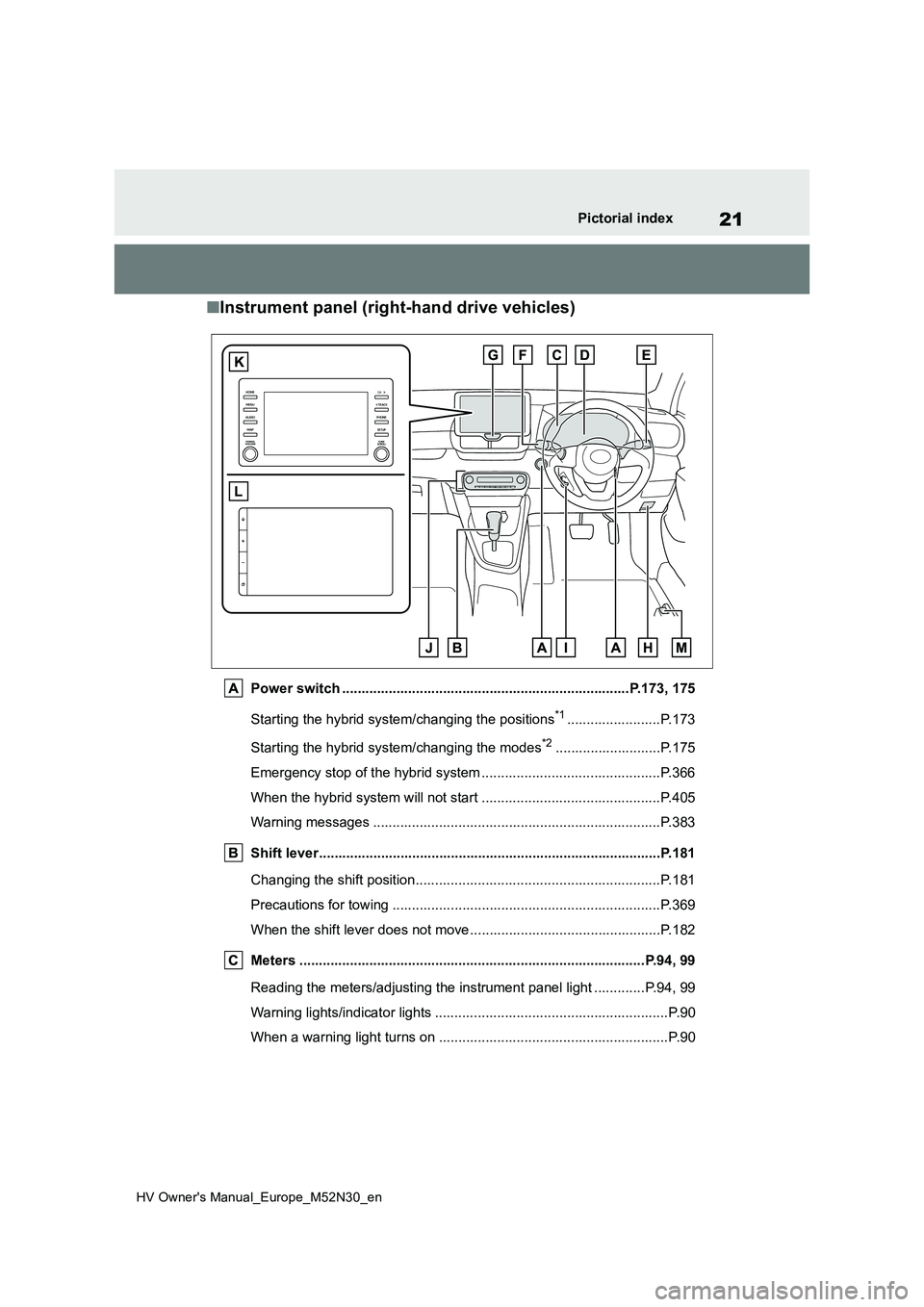
21
HV Owner's Manual_Europe_M52N30_en
Pictorial index
■Instrument panel (right-hand drive vehicles)
Power switch ..........................................................................P.173, 175
Starting the hybrid system/changing the positions*1........................P.173
Starting the hybrid system/changing the modes*2...........................P.175
Emergency stop of the hybrid system ............................ ..................P.366
When the hybrid system will not start .......................... ....................P.405
Warning messages ............................................... ...........................P.383
Shift lever.................................................... ....................................P.181
Changing the shift position.................................... ...........................P.181
Precautions for towing ......................................... ............................P.369
When the shift lever does not move............................. ....................P.182
Meters ......................................................... ................................P.94, 99
Reading the meters/adjusting the instrument panel light ........ .....P.94, 99
Warning lights/indicator lights ................................ ............................P.90
When a warning light turns on .................................. .........................P.90
Page 37 of 590
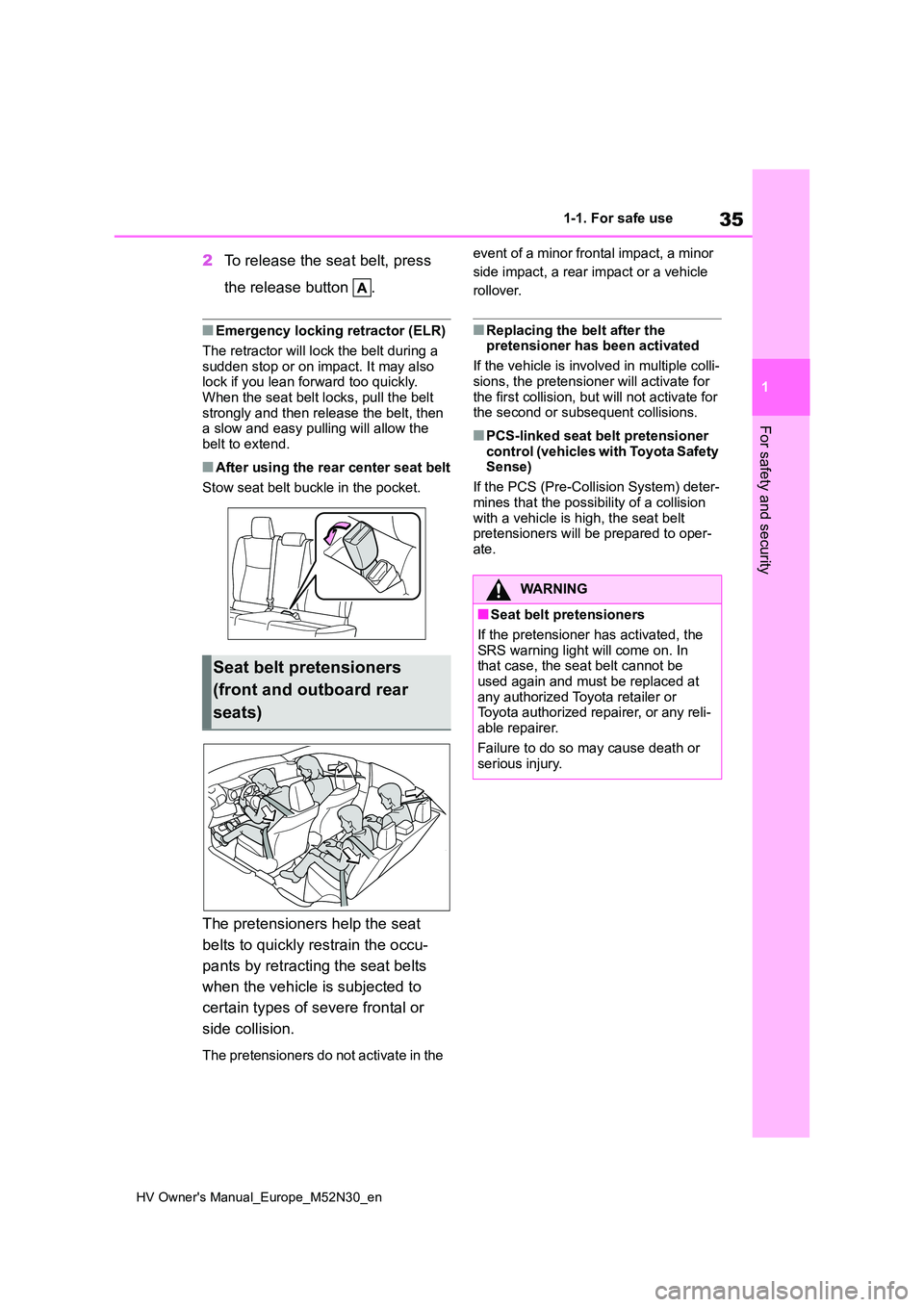
35
1
HV Owner's Manual_Europe_M52N30_en
1-1. For safe use
For safety and security
2To release the seat belt, press
the release button .
■Emergency locking retractor (ELR)
The retractor will lock the belt during a sudden stop or on impact. It may also lock if you lean forward too quickly.
When the seat belt locks, pull the belt strongly and then release the belt, then a slow and easy pulling will allow the
belt to extend.
■After using the rear center seat belt
Stow seat belt buckle in the pocket.
The pretensioners help the seat
belts to quickly restrain the occu-
pants by retracting the seat belts
when the vehicle is subjected to
certain types of severe frontal or
side collision.
The pretensioners do not activate in the
event of a minor frontal impact, a minor
side impact, a rear impact or a vehicle
rollover.
■Replacing the belt after the pretensioner has been activated
If the vehicle is involved in multiple colli-
sions, the pretensioner will activate for the first collision, but will not activate for the second or subsequent collisions.
■PCS-linked seat belt pretensioner
control (vehicles with Toyota Safety Sense)
If the PCS (Pre-Collision System) deter-
mines that the possibility of a collision with a vehicle is high, the seat belt pretensioners will be prepared to oper-
ate.
Seat belt pretensioners
(front and outboard rear
seats)
WARNING
■Seat belt pretensioners
If the pretensioner has activated, the SRS warning light will come on. In that case, the seat belt cannot be
used again and must be replaced at any authorized Toyota retailer or Toyota authorized repairer, or any reli-
able repairer.
Failure to do so may cause death or serious injury.
Page 43 of 590
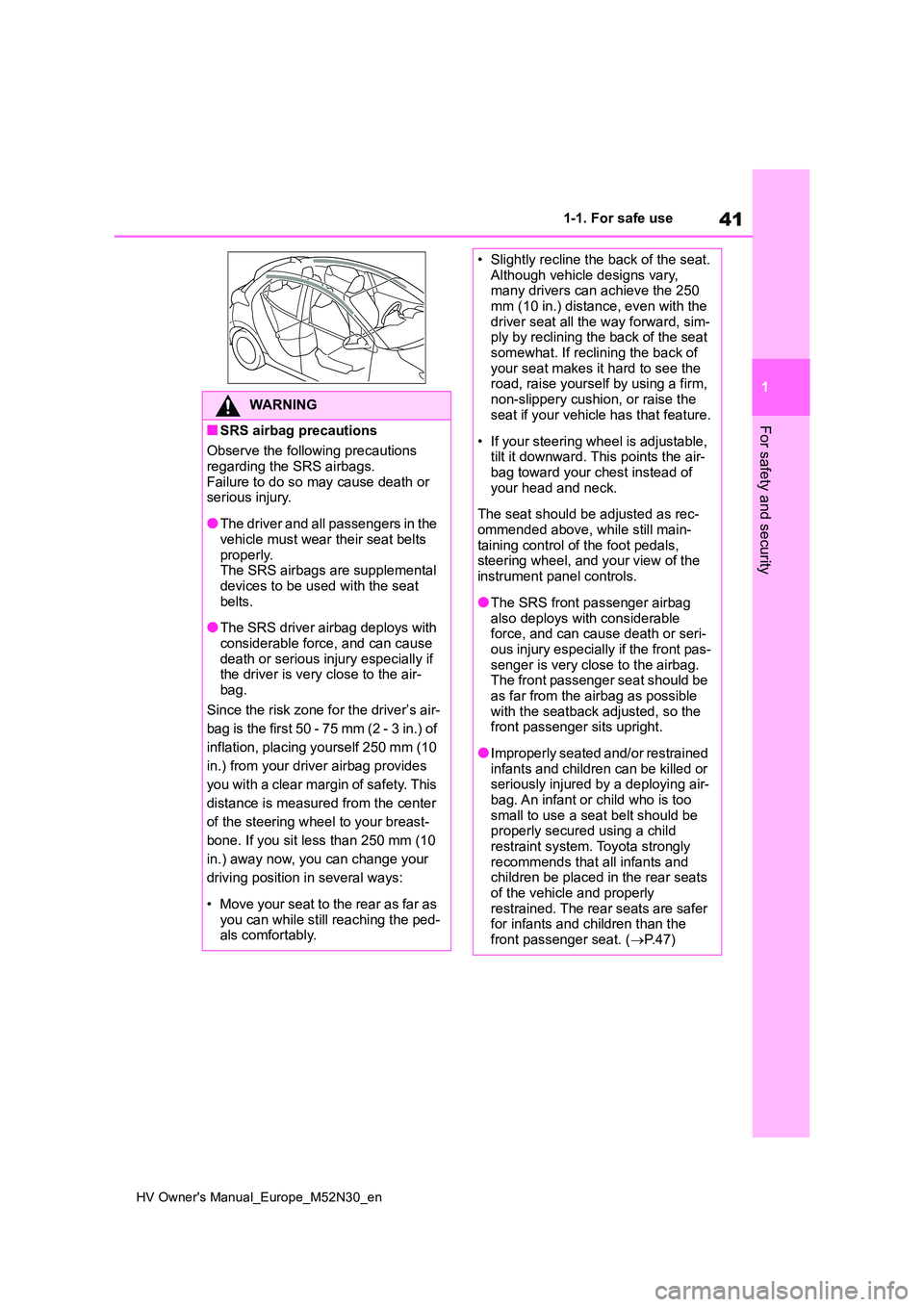
41
1
HV Owner's Manual_Europe_M52N30_en
1-1. For safe use
For safety and security
WARNING
■SRS airbag precautions
Observe the following precautions
regarding the SRS airbags. Failure to do so may cause death or serious injury.
●The driver and all passengers in the vehicle must wear their seat belts
properly. The SRS airbags are supplemental devices to be used with the seat
belts.
●The SRS driver airbag deploys with
considerable force, and can cause death or serious injury especially if the driver is very close to the air-
bag.
Since the risk zone for the driver’s air-
bag is the first 50 - 75 mm (2 - 3 in.) of
inflation, placing yourself 250 mm (10
in.) from your driver airbag provides
you with a clear margin of safety. This
distance is measured from the center
of the steering wheel to your breast-
bone. If you sit less than 250 mm (10
in.) away now, you can change your
driving position in several ways:
• Move your seat to the rear as far as you can while still reaching the ped-als comfortably.
• Slightly recline the back of the seat.Although vehicle designs vary, many drivers can achieve the 250
mm (10 in.) distance, even with the driver seat all the way forward, sim-ply by reclining the back of the seat
somewhat. If reclining the back of your seat makes it hard to see the road, raise yourself by using a firm,
non-slippery cushion, or raise the seat if your vehicle has that feature.
• If your steering wheel is adjustable, tilt it downward. This points the air-bag toward your chest instead of
your head and neck.
The seat should be adjusted as rec-
ommended above, while still main- taining control of the foot pedals, steering wheel, and your view of the
instrument panel controls.
●The SRS front passenger airbag
also deploys with considerable force, and can cause death or seri-ous injury especially if the front pas-
senger is very close to the airbag. The front passenger seat should be as far from the airbag as possible
with the seatback adjusted, so the front passenger sits upright.
●Improperly seated and/or restrained infants and children can be killed or seriously injured by a deploying air-
bag. An infant or child who is too small to use a seat belt should be properly secured using a child
restraint system. Toyota strongly recommends that all infants and children be placed in the rear seats
of the vehicle and properly restrained. The rear seats are safer for infants and children than the
front passenger seat. ( P. 4 7 )
Page 44 of 590
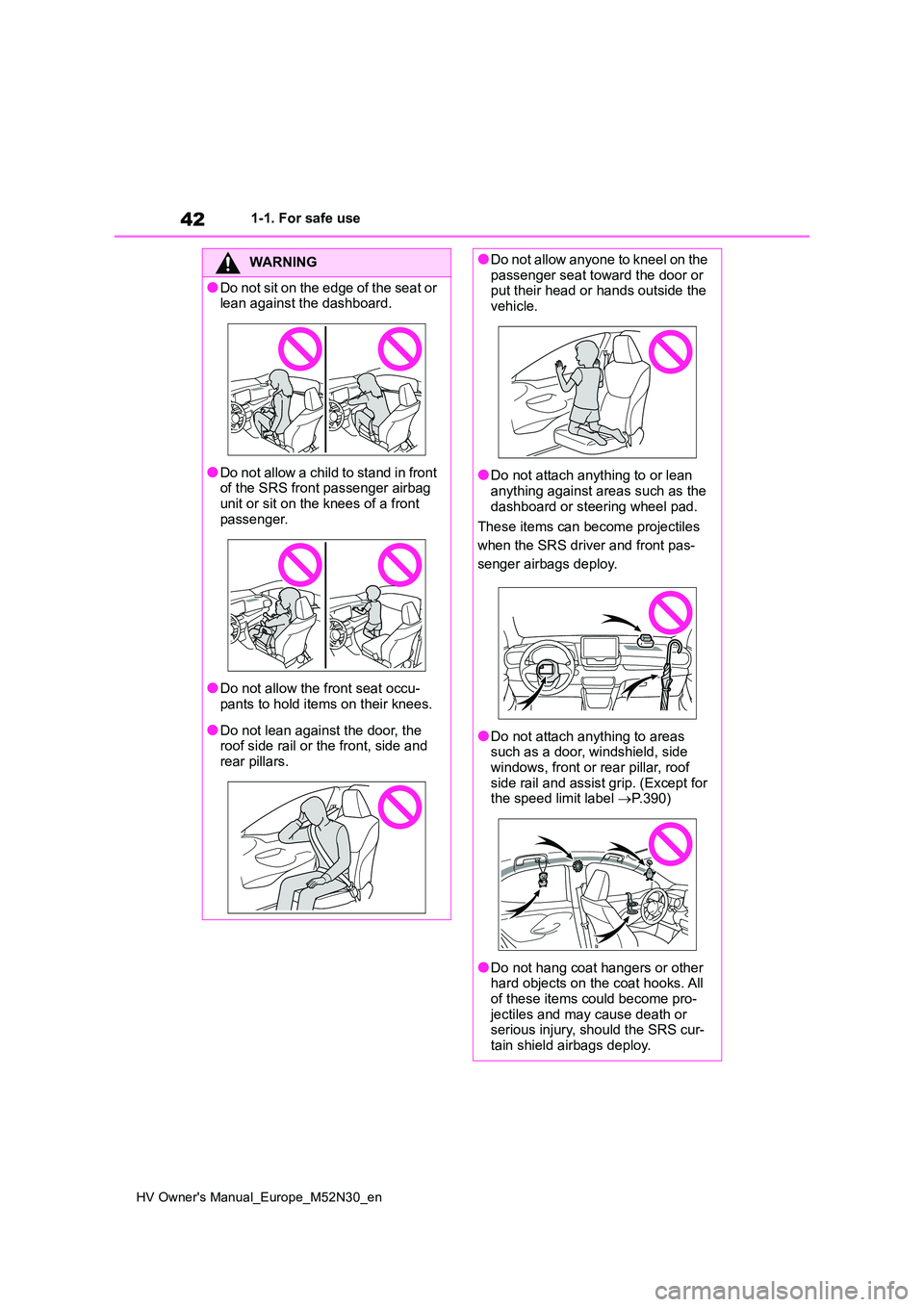
42
HV Owner's Manual_Europe_M52N30_en
1-1. For safe use
WARNING
●Do not sit on the edge of the seat or lean against the dashboard.
●Do not allow a child to stand in front of the SRS front passenger airbag
unit or sit on the knees of a front passenger.
●Do not allow the front seat occu-pants to hold items on their knees.
●Do not lean against the door, the roof side rail or the front, side and rear pillars.
●Do not allow anyone to kneel on the passenger seat toward the door or put their head or hands outside the
vehicle.
●Do not attach anything to or lean
anything against areas such as the dashboard or steering wheel pad.
These items can become projectiles
when the SRS driver and front pas-
senger airbags deploy.
●Do not attach anything to areas such as a door, windshield, side windows, front or rear pillar, roof
side rail and assist grip. (Except for the speed limit label P.390)
●Do not hang coat hangers or other hard objects on the coat hooks. All of these items could become pro-
jectiles and may cause death or serious injury, should the SRS cur-tain shield airbags deploy.
Page 64 of 590
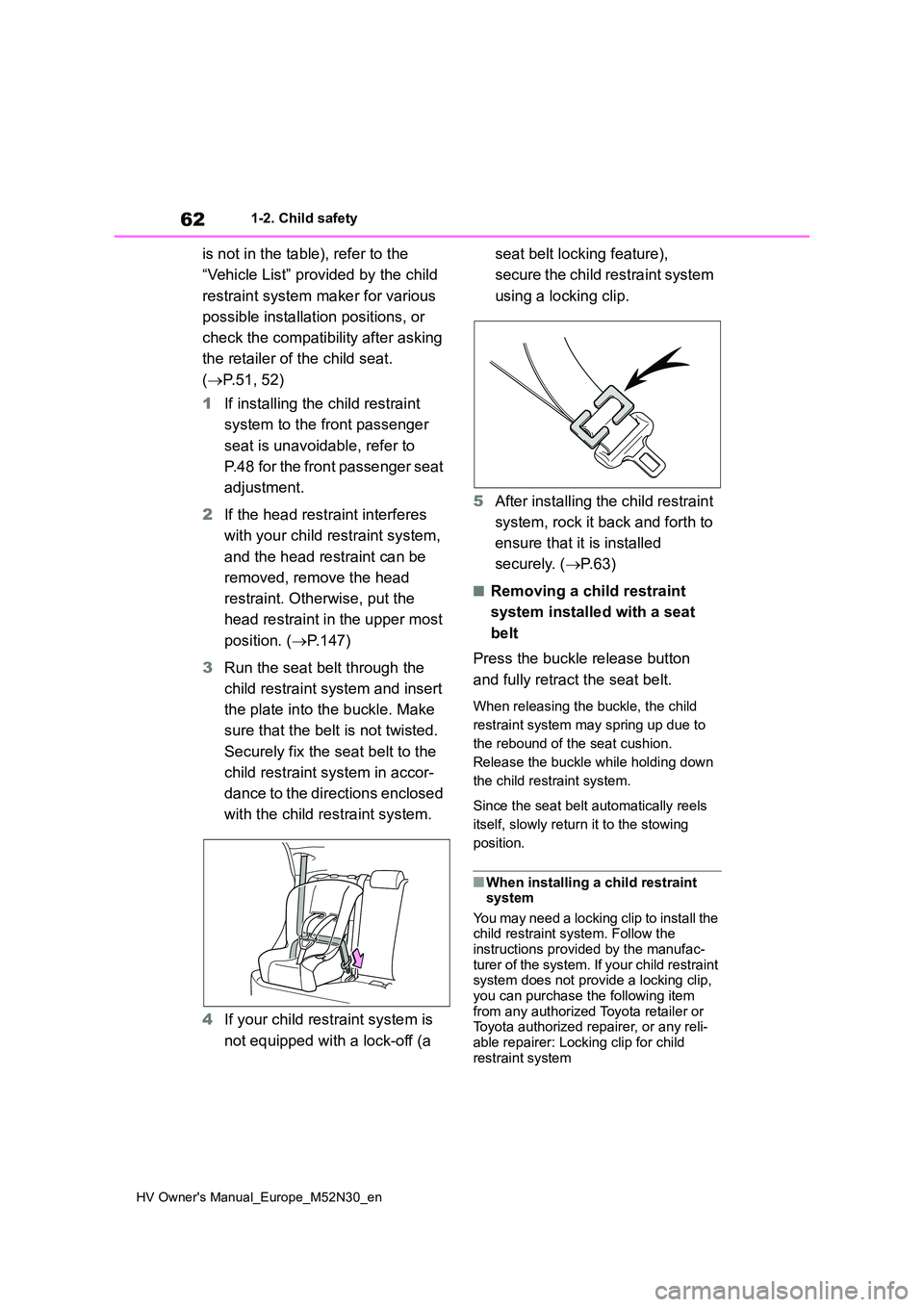
62
HV Owner's Manual_Europe_M52N30_en
1-2. Child safety
is not in the table), refer to the
“Vehicle List” provided by the child
restraint system maker for various
possible installation positions, or
check the compatibility after asking
the retailer of the child seat.
( P.51, 52)
1 If installing the child restraint
system to the front passenger
seat is unavoidable, refer to
P.48 for the front passenger seat
adjustment.
2 If the head restraint interferes
with your child restraint system,
and the head restraint can be
removed, remove the head
restraint. Otherwise, put the
head restraint in the upper most
position. ( P.147)
3 Run the seat belt through the
child restraint system and insert
the plate into the buckle. Make
sure that the belt is not twisted.
Securely fix the seat belt to the
child restraint system in accor-
dance to the directions enclosed
with the child restraint system.
4 If your child restraint system is
not equipped with a lock-off (a
seat belt locking feature),
s e c u r e t h e c h i l d r e s t r a i n t s y s t e m
using a locking clip.
5 After installing the child restraint
system, rock it back and forth to
ensure that it is installed
securely. ( P. 6 3 )
■Removing a child restraint
system installed with a seat
belt
Press the buckle release button
and fully retract the seat belt.
When releasing the buckle, the child
restraint system may spring up due to
the rebound of the seat cushion.
Release the buckle while holding down
the child restraint system.
Since the seat belt automatically reels
itself, slowly return it to the stowing
position.
■When installing a child restraint system
You may need a locking clip to install the child restraint system. Follow the
instructions provided by the manufac- turer of the system. If your child restraint system does not provide a locking clip,
you can purchase the following item from any authorized Toyota retailer or Toyota authorized repairer, or any reli-
able repairer: Locking clip for child restraint system
Page 83 of 590
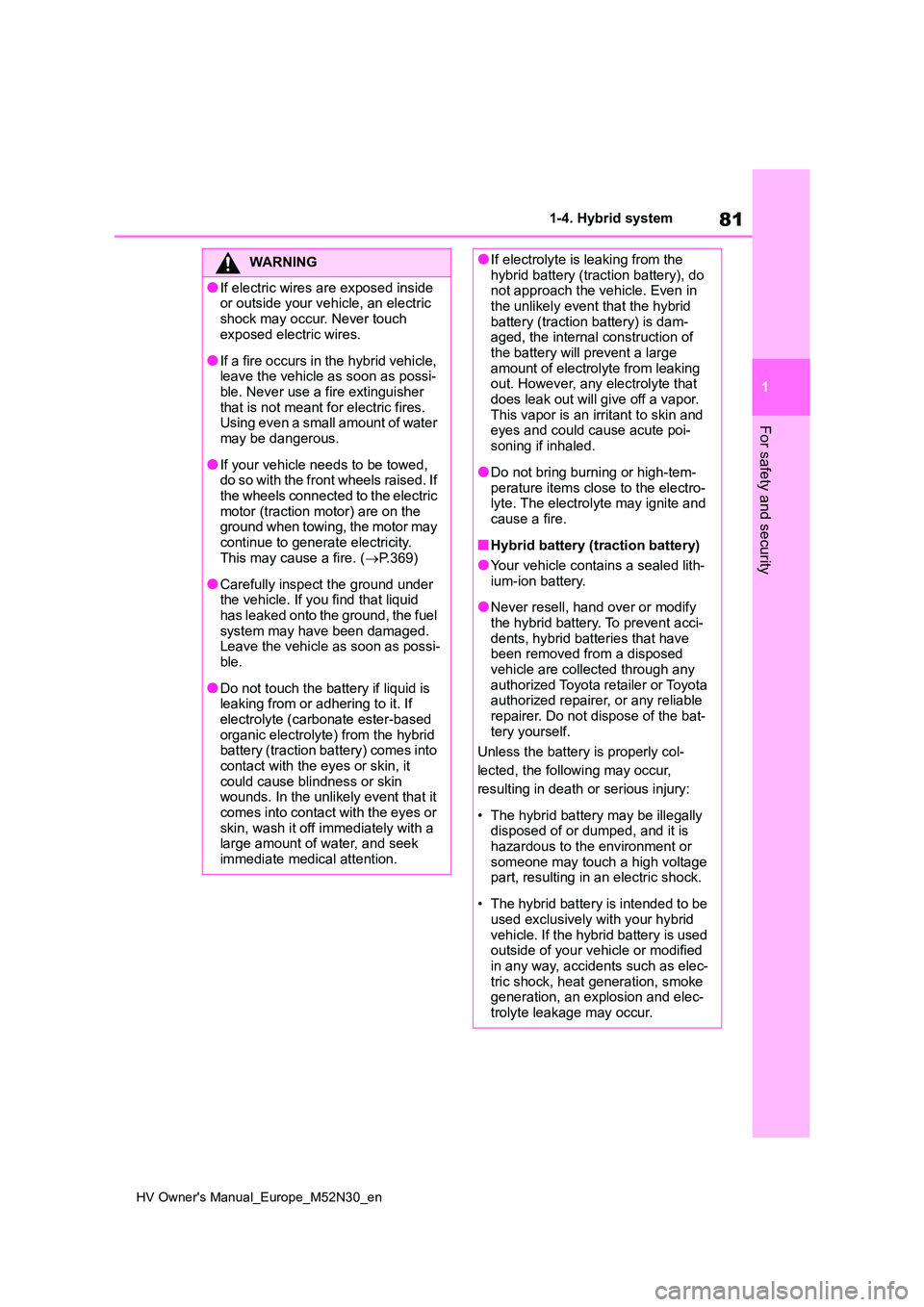
81
1
HV Owner's Manual_Europe_M52N30_en
1-4. Hybrid system
For safety and security
WARNING
●If electric wires are exposed inside or outside your vehicle, an electric
shock may occur. Never touch exposed electric wires.
●If a fire occurs in the hybrid vehicle, leave the vehicle as soon as possi-ble. Never use a fire extinguisher
that is not meant for electric fires. Using even a small amount of water may be dangerous.
●If your vehicle needs to be towed, do so with the front wheels raised. If
the wheels connected to the electric motor (traction motor) are on the ground when towing, the motor may
continue to generate electricity. This may cause a fire. ( P.369)
●Carefully inspect the ground under the vehicle. If you find that liquid has leaked onto the ground, the fuel
system may have been damaged. Leave the vehicle as soon as possi-ble.
●Do not touch the battery if liquid is leaking from or adhering to it. If
electrolyte (carbonate ester-based organic electrolyte) from the hybrid battery (traction battery) comes into
contact with the eyes or skin, it could cause blindness or skin wounds. In the unlikely event that it
comes into contact with the eyes or skin, wash it off immediately with a large amount of water, and seek
immediate medical attention.
●If electrolyte is leaking from the hybrid battery (traction battery), do not approach the vehicle. Even in
the unlikely event that the hybrid battery (traction battery) is dam-aged, the internal construction of
the battery will prevent a large amount of electrolyte from leaking out. However, any electrolyte that
does leak out will give off a vapor. This vapor is an irritant to skin and eyes and could cause acute poi-
soning if inhaled.
●Do not bring burning or high-tem-
perature items close to the electro- lyte. The electrolyte may ignite and cause a fire.
■Hybrid battery (traction battery)
●Your vehicle contains a sealed lith-
ium-ion battery.
●Never resell, hand over or modify
the hybrid battery. To prevent acci- dents, hybrid batteries that have been removed from a disposed
vehicle are collected through any authorized Toyota retailer or Toyota authorized repairer, or any reliable
repairer. Do not dispose of the bat- tery yourself.
Unless the battery is properly col-
lected, the following may occur,
resulting in death or serious injury:
• The hybrid battery may be illegally disposed of or dumped, and it is
hazardous to the environment or someone may touch a high voltage part, resulting in an electric shock.
• The hybrid battery is intended to be used exclusively with your hybrid
vehicle. If the hybrid battery is used outside of your vehicle or modified in any way, accidents such as elec-
tric shock, heat generation, smoke generation, an explosion and elec-trolyte leakage may occur.
Page 133 of 590
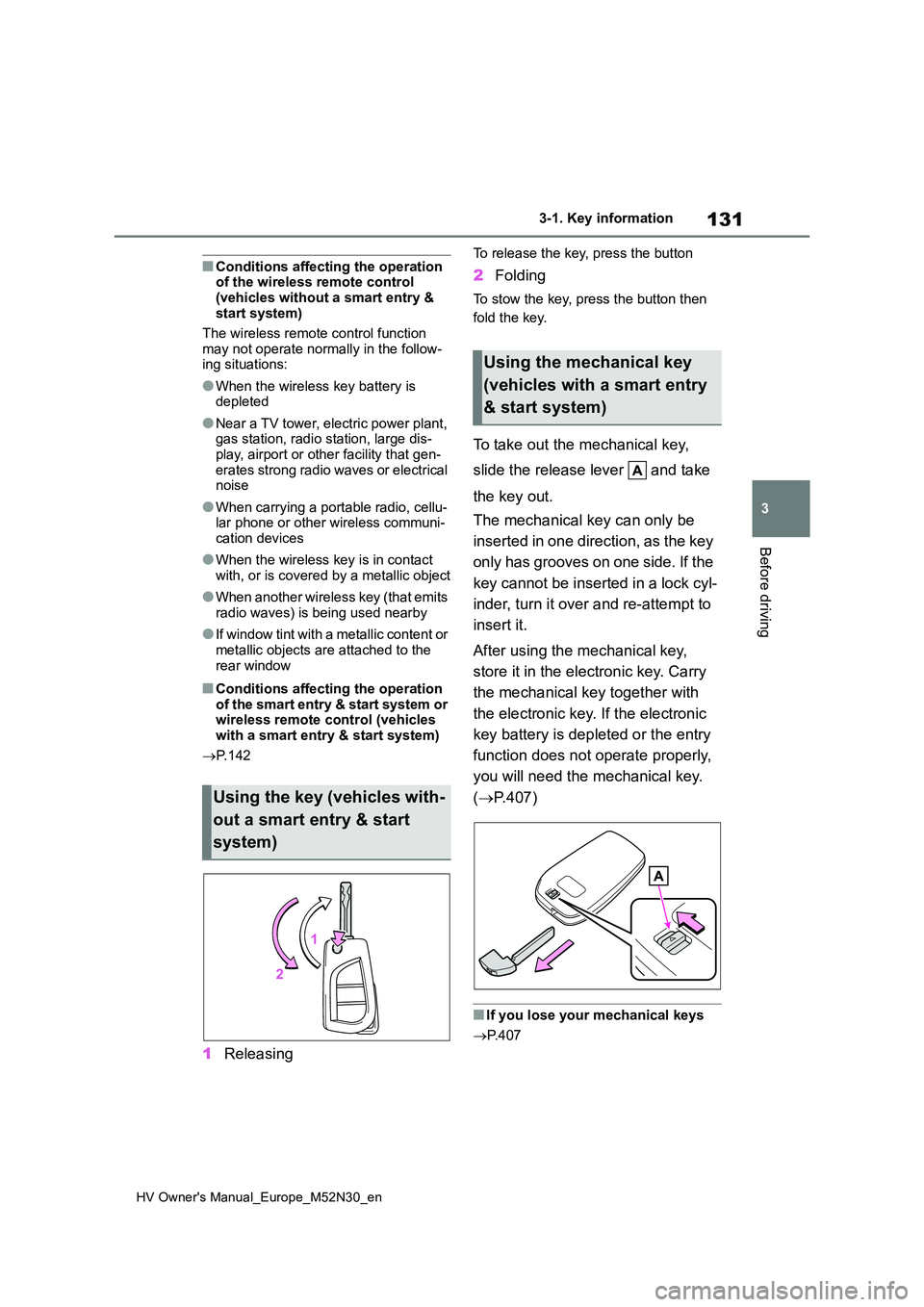
131
3
HV Owner's Manual_Europe_M52N30_en
3-1. Key information
Before driving
■Conditions affecting the operation of the wireless remote control
(vehicles without a smart entry & start system)
The wireless remote control function
may not operate normally in the follow- ing situations:
●When the wireless key battery is depleted
●Near a TV tower, electric power plant, gas station, radio station, large dis-play, airport or other facility that gen-
erates strong radio waves or electrical noise
●When carrying a portable radio, cellu-lar phone or other wireless communi-cation devices
●When the wireless key is in contact with, or is covered by a metallic object
●When another wireless key (that emits radio waves) is being used nearby
●If window tint with a metallic content or metallic objects are attached to the
rear window
■Conditions affecting the operation of the smart entry & start system or wireless remote control (vehicles
with a smart entry & start system)
P. 1 4 2
1Releasing
To release the key, press the button
2Folding
To stow the key, press the button then
fold the key.
To take out the mechanical key,
slide the release lever and take
the key out.
The mechanical key can only be
inserted in one direction, as the key
only has grooves on one side. If the
key cannot be inserted in a lock cyl-
inder, turn it over and re-attempt to
insert it.
After using the mechanical key,
store it in the electronic key. Carry
the mechanical key together with
the electronic key. If the electronic
key battery is depleted or the entry
function does not operate properly,
you will need the mechanical key.
( P.407)
■If you lose your mechanical keys
P. 4 0 7
Using the key (vehicles with-
out a smart entry & start
system)
Using the mechanical key
(vehicles with a smart entry
& start system)